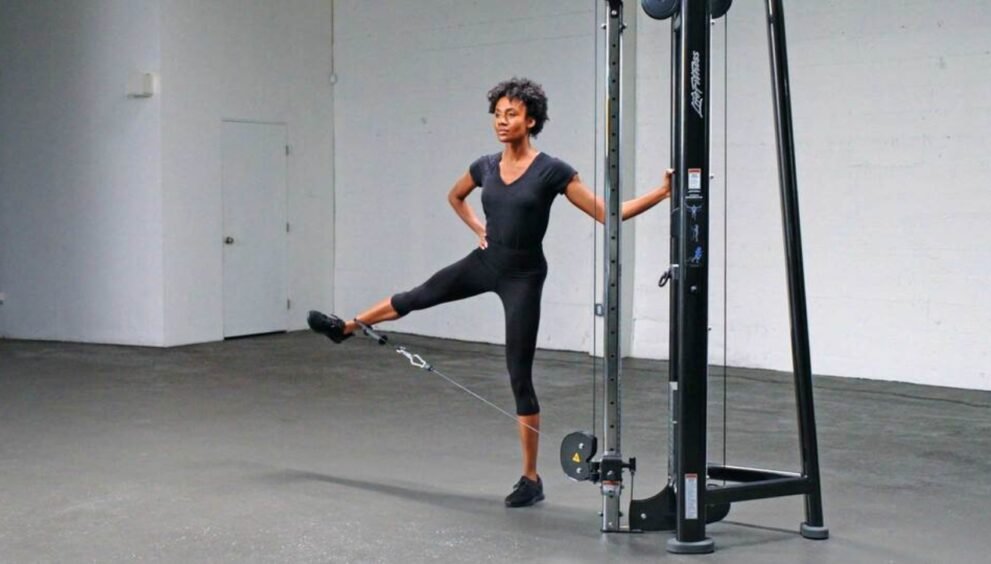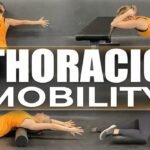The Ultimate Guide to Standing Hip Abduction

Are you ready to strengthen your hips, tone your glutes, and improve your overall stability? If so, then standing hip abduction exercises are your answer. This simple yet effective movement can be a game-changer for both athletes and anyone looking to enhance their lower body strength. In this guide, we’ll dive into everything you need to know about standing hip abduction, from proper form and benefits to variations and integration into your workout routine. Get ready to unlock the power of your hips!
Understanding the Power of Standing Hip Abduction
Standing hip abduction is an exercise that targets the muscles responsible for moving your leg away from the midline of your body. Primarily, this movement engages the gluteus medius and gluteus minimus, which are crucial for hip stability and pelvic alignment. Other supporting muscles, such as the tensor fasciae latae (TFL) and quadratus lumborum, also get involved.
This exercise is typically performed standing and can be modified to suit different fitness levels and goals. You can use resistance bands, ankle weights, or even just your body weight to perform the movement. Consequently, the standing hip abduction becomes a versatile addition to any workout program.
Why is Hip Abduction Important?
Hip abduction plays a significant role in everyday movements and athletic performance. Strong hip abductors contribute to:
- Improved Stability: Strong hip abductors are essential for maintaining balance and preventing falls, especially as we age.
- Enhanced Athletic Performance: For athletes, hip abduction strength is crucial for activities like running, jumping, and lateral movements.
- Injury Prevention: Weak hip abductors can lead to imbalances that contribute to knee pain, hip pain, and even lower back pain.
- Better Posture: Strong hip muscles help maintain proper pelvic alignment, which contributes to better overall posture.
Many people overlook the importance of hip strength, but it’s essential to address any weakness to function well and reduce pain. The hip abductors are important in single leg stance activities such as walking, running, and climbing stairs. Without adequate hip abduction strength, other muscles compensate leading to pain and potential injury.
Perfecting Your Form for Standing Hip Abduction
To get the most out of standing hip abduction and avoid injury, it’s crucial to maintain proper form. Here’s a step-by-step guide to help you master the technique:
- Starting Position: Stand tall with your feet hip-width apart. Engage your core to stabilize your spine. You can hold onto a chair or wall for balance, if needed.
- Movement: Keeping your leg straight, slowly lift one leg out to the side, away from your body. Focus on using your hip muscles to initiate the movement.
- Peak Contraction: At the top of the movement, pause briefly and squeeze your glute muscles.
- Controlled Return: Slowly lower your leg back to the starting position, maintaining control throughout the movement.
- Repetitions: Perform 10-15 repetitions on one leg, then switch to the other leg.
Common Mistakes to Avoid
- Leaning to the Side: Avoid leaning to the side as you lift your leg. This shifts the focus away from your hip abductors and can strain your lower back.
- Bending the Knee: Keep your leg straight throughout the movement to effectively target the hip muscles.
- Swinging the Leg: Control the movement rather than swinging your leg. Swinging uses momentum instead of muscle strength, reducing the exercise’s effectiveness.
- Lifting Too High: Lifting your leg too high can compromise your form and lead to hip impingement. Focus on controlled abduction rather than maximizing the height of the lift.
Reddit users often discuss these common mistakes and share tips on maintaining proper form. One user mentioned using a mirror to monitor their technique and ensure they weren’t leaning or swinging their leg.
Using Resistance Bands for Added Intensity
Resistance bands can significantly increase the challenge of standing hip abduction. Here’s how to incorporate them:
- Placement: Place a resistance band around your ankles or just above your knees.
- Execution: Perform the standing hip abduction as described above, but against the resistance of the band.
- Progression: As you get stronger, you can increase the resistance of the band to continue challenging your muscles.
The bands will require a greater effort to abduct the leg. Therefore, choose a band strength that matches your fitness level.
Benefits Beyond the Booty: Why Standing Hip Abduction Matters
The primary benefit of standing hip abduction is, of course, strengthening the hip abductor muscles. The gluteus medius and minimus are essential for hip stability, pelvic alignment, and proper gait mechanics. Strong hip abductors help prevent injuries and improve overall lower body function.
Improving Balance and Stability
Strong hip abductors are crucial for maintaining balance, especially on one leg. This is particularly important for activities like walking, running, and climbing stairs. By strengthening these muscles, you can improve your stability and reduce your risk of falls.
Preventing and Rehabilitating Injuries
Weak hip abductors are often associated with various injuries, including:
- Knee Pain: Weak hip abductors can cause the knee to track improperly, leading to pain and discomfort.
- Hip Pain: Insufficient hip strength can contribute to hip impingement, bursitis, and other hip-related issues.
- Lower Back Pain: Pelvic instability caused by weak hip abductors can strain the lower back muscles, leading to pain and discomfort.
Performing standing hip abduction exercises can help address these weaknesses and prevent or rehabilitate these injuries. Furthermore, targeted exercises help restore proper biomechanics and alleviate pain.
Enhancing Athletic Performance
For athletes, strong hip abductors are essential for activities that involve lateral movement, such as basketball, tennis, and soccer. Strong hips allow for more efficient and powerful movements, improving overall athletic performance. Moreover, the exercises can improve agility and speed.
Variations and Progressions for Standing Hip Abduction
The most basic form of this exercise is using your body weight. This is a great starting point for beginners or for those who are returning to exercise after an injury. Focus on maintaining proper form and controlling the movement throughout the entire range of motion.
Resistance Band Standing Hip Abduction
As mentioned earlier, resistance bands can add an extra layer of challenge to the exercise. Experiment with different resistance levels to find what works best for you. Ensure that you have proper form before you increase resistance.
Ankle Weight Standing Hip Abduction
Adding ankle weights is another way to increase the intensity of the exercise. Start with light weights and gradually increase the weight as you get stronger. Ankle weights will have a greater torque on the hip compared to resistance bands, therefore be cautious using ankle weights.
Cable Machine Hip Abduction
Using a cable machine allows for consistent resistance throughout the entire movement. Attach an ankle cuff to the cable and perform the hip abduction while standing next to the machine. Adjust the weight as needed to challenge your muscles without compromising form.
Dynamic Standing Hip Abduction
This variation involves adding a slight hop or jump at the top of the movement. This helps improve power and explosiveness in the hip abductors. However, this variation is more advanced and should be performed with caution.
Integrating Standing Hip Abduction into Your Workout Routine
Here’s a sample workout plan that incorporates standing hip abduction exercises:
- Warm-up: 5 minutes of light cardio, such as jogging or jumping jacks.
- Standing Hip Abduction: 3 sets of 15 repetitions on each leg with a resistance band.
- Glute Bridge: 3 sets of 12 repetitions.
- Clamshells: 3 sets of 15 repetitions on each side.
- Side Plank with Hip Abduction: 3 sets of 10 repetitions on each side.
- Cool-down: 5 minutes of static stretching, focusing on the glutes, hips, and hamstrings.
Frequency and Sets/Reps
Aim to perform standing hip abduction exercises 2-3 times per week, allowing for at least one day of rest in between sessions. Start with 2-3 sets of 10-15 repetitions on each leg, and gradually increase the sets and repetitions as you get stronger.
Combining with Other Exercises
Standing hip abduction can be effectively combined with other lower body exercises, such as squats, lunges, and deadlifts. This creates a well-rounded workout that targets all major muscle groups in the lower body. Adding hip abduction exercises before squats or lunges can help activate the glute muscles and improve overall performance.
Expert Insights on Hip Abduction Exercises
I spoke with Dr. Sarah Johnson, a physical therapist specializing in sports medicine, who shared her insights on the importance of hip abduction exercises.
“Hip abduction exercises are often overlooked, but they are crucial for maintaining proper alignment and stability in the lower body,”
says Dr. Johnson.
“Weak hip abductors can lead to a variety of issues, including knee pain, hip pain, and even lower back pain. Incorporating exercises like standing hip abduction into your routine can help prevent these issues and improve your overall function.”
Dr. Johnson also emphasized the importance of proper form and progression.
“It’s essential to start with bodyweight exercises and gradually increase the resistance as you get stronger,”
she advised.
“Listen to your body and avoid pushing yourself too hard, especially when you’re first starting out.”
Addressing Common Concerns and Myths
This is a common misconception. While hip abduction exercises are popular among women looking to tone their glutes, they are beneficial for everyone, regardless of gender. Strong hip abductors are essential for stability, injury prevention, and athletic performance for both men and women.
Myth: You Need Heavy Weights to Strengthen Your Hip Abductors
While adding weight can increase the intensity of the exercise, it’s not necessary to achieve results. Bodyweight exercises and resistance bands can be highly effective, especially when performed with proper form and controlled movements.
Concern: I Have Hip Pain. Should I Avoid Hip Abduction Exercises?
If you have hip pain, it’s essential to consult with a healthcare professional before starting any new exercise program. In some cases, hip abduction exercises may be beneficial for rehabilitation, but it’s crucial to get a proper diagnosis and guidance from a qualified professional. Avoid any exercises that exacerbate your pain.
Conclusion: Embrace the Power of Standing Hip Abduction
Standing hip abduction is a simple yet powerful exercise that offers a wide range of benefits, from strengthening key muscles and improving balance to preventing injuries and enhancing athletic performance. By incorporating this exercise into your routine and focusing on proper form, you can unlock the power of your hips and improve your overall function. Don’t underestimate the impact of strong hip abductors – they are essential for a healthy, active lifestyle. So, stand tall, engage your core, and start abducting your way to a stronger, more stable you!
































































































































































































































































































































































































